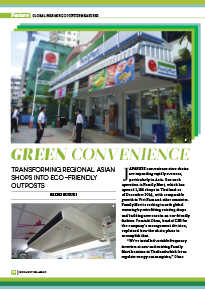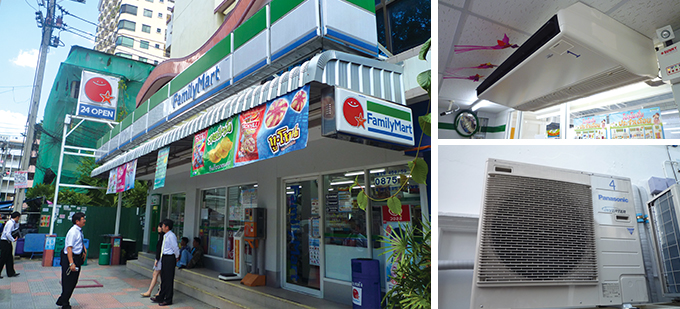Home > Highlighting JAPAN >Highlighting Japan February 2015>Global warming countermeasures
Highlighting JAPAN

Global warming countermeasures
Green Convenience
Transforming regional Asian shops
into eco-friendly outposts

Japanese convenience store chains are expanding rapidly overseas, particularly in Asia. One such operation is Family Mart, which has opened 1,186 shops in Thailand as of December 2014, with comparable growth in Viet Nam and other countries. Family Mart is seeking to curb global warming by retrofitting existing shops and building new ones in an eco-friendly fashion. Fumiaki Ohno, head of CSR for the company’s management division, explained how the chain plans to accomplish that.
“We’ve installed variable frequency inverters at new and existing Family Mart locations in Thailand which let us regulate energy consumption,” Ohno notes. “This is one of the trial projects to utilize the Bilateral Offset Credit Mechanism (BOCM), a mechanism whose prompt development and deployment is yet to be achieved.”
The BOCM works to reach Japan’s energy reduction goals by using greenhouse gas-reducing technologies, products, systems, services and infrastructure in developing countries and quantitatively assessing the degree of emissions this would equate to in Japan. Global warming prevention measures in Asia are still lagging, and with Japanese convenience stores expected to multiply at a rapid pace, their ecological efforts represent one practical approach to the BOCM.
According to Ohno, the equipment at Family Mart locations in Asia was primarily procured locally. “While we recognized that deploying Japanese refrigerators and air conditioners with built-in inverter control technology would reach our energy output goals, at the time we felt local machinery was more cost effective and easier to obtain. To improve this situation, at a 2011 meeting of Family Mart’s upper management from Japan and overseas, it was decided that each shop had to reduce its energy output by 20 percent by 2015, so this spurred the ‘eco-ification’ of shop infrastructure. Today, these conditions have improved significantly.”
Although these shops come in different shapes and sizes—some are one-story roadside stores, some have two floors, and others are in business complexes—the energy consumption of a typical Family Mart breaks down to 16 percent for air conditioning, 18 percent for lighting, 41 percent for refrigerated cases, and 25 percent for other uses. Air conditioning, lighting, and refrigeration make up 70 percent of the total energy consumption; changing them over to inverter-based units equates to an annual energy reduction of 34 percent. However, inverter-equipped machinery is 20 to 30 percent more expensive than the standard variety, so initial costs are higher. In many cases, business owners hesitate to make the initial investment, even though the longer service life of eco-friendly machines means those costs can be reclaimed.
“For our locations in Thailand, since there is a Panasonic plant nearby, we use Panasonic inverters which offer great energy reduction. As these devices are sold, it stimulates Japanese industry, and the process as a whole also improves the international reputation of Japan’s countermeasures against global warming at large as well as C02 emissions. There are many advantages to this project,” Ohno states.
In this way, Japanese technology, expertise and business are being geared to curb greenhouse gas emissions both at home and in developing countries.
© 2009 Cabinet Office, Government of Japan






